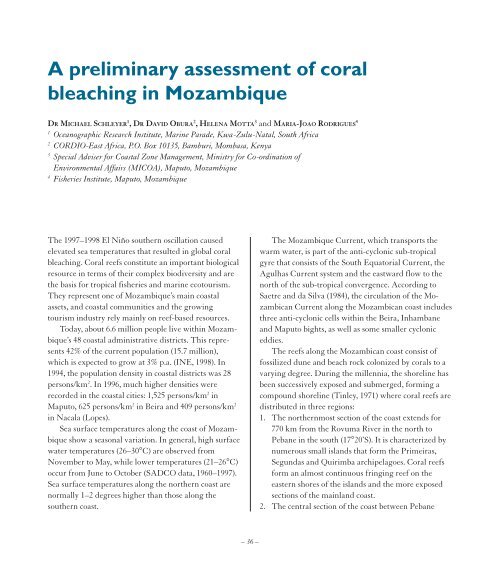You also want an ePaper? Increase the reach of your titles
YUMPU automatically turns print PDFs into web optimized ePapers that Google loves.
A preliminary assessment of coral<br />
bleaching in Mozambique<br />
DR MICHAEL SCHLEYER 1 , DR DAVID OBURA 2 , HELENA MOTTA 3 and MARIA-JOAO RODRIGUES 4<br />
1<br />
Oceanographic Research Institute, Marine Parade, Kwa-Zulu-Natal, South Africa<br />
2<br />
<strong>CORDIO</strong>-East Africa, P.O. Box 10135, Bamburi, Mombasa, Kenya<br />
3<br />
Special Adviser for Coastal Zone Management, Ministry for Co-ordination of<br />
Environmental Affairs (MICOA), Maputo, Mozambique<br />
4<br />
Fisheries Institute, Maputo, Mozambique<br />
The 1997–1998 El Niño southern oscillation caused<br />
elevated sea temperatures that resulted in global coral<br />
bleaching. Coral reefs constitute an important biological<br />
resource in terms of their complex biodiversity and are<br />
the basis for tropical fisheries and marine ecotourism.<br />
They represent one of Mozambique’s main coastal<br />
assets, and coastal communities and the growing<br />
tourism industry rely mainly on reef-based resources.<br />
Today, about 6.6 million people live within Mozambique’s<br />
48 coastal administrative districts. This represents<br />
42% of the current population (15.7 million),<br />
which is expected to grow at 3% p.a. (INE, 1998). In<br />
1994, the population density in coastal districts was 28<br />
persons/km 2 . In 1996, much higher densities were<br />
recorded in the coastal cities: 1,525 persons/km 2 in<br />
Maputo, 625 persons/km 2 in Beira and 409 persons/km 2<br />
in Nacala (Lopes).<br />
Sea surface temperatures along the coast of Mozambique<br />
show a seasonal variation. In general, high surface<br />
water temperatures (26–30°C) are observed from<br />
November to May, while lower temperatures (21–26°C)<br />
occur from June to October (SADCO data, 1960–1997).<br />
Sea surface temperatures along the northern coast are<br />
normally 1–2 degrees higher than those along the<br />
southern coast.<br />
The Mozambique Current, which transports the<br />
warm water, is part of the anti-cyclonic sub-tropical<br />
gyre that consists of the South Equatorial Current, the<br />
Agulhas Current system and the eastward flow to the<br />
north of the sub-tropical convergence. According to<br />
Saetre and da Silva (1984), the circulation of the Mozambican<br />
Current along the Mozambican coast includes<br />
three anti-cyclonic cells within the Beira, Inhambane<br />
and Maputo bights, as well as some smaller cyclonic<br />
eddies.<br />
The reefs along the Mozambican coast consist of<br />
fossilized dune and beach rock colonized by corals to a<br />
varying degree. During the millennia, the shoreline has<br />
been successively exposed and submerged, forming a<br />
compound shoreline (Tinley, 1971) where coral reefs are<br />
distributed in three regions:<br />
1. The northernmost section of the coast extends for<br />
770 km from the Rovuma River in the north to<br />
Pebane in the south (17°20’S). It is characterized by<br />
numerous small islands that form the Primeiras,<br />
Segundas and Quirimba archipelagoes. Coral reefs<br />
form an almost continuous fringing reef on the<br />
eastern shores of the islands and the more exposed<br />
sections of the mainland coast.<br />
2. The central section of the coast between Pebane<br />
– 36 –


















